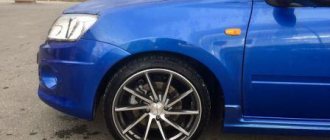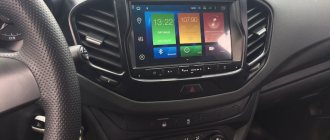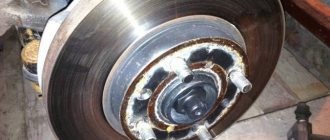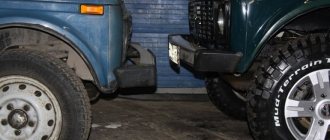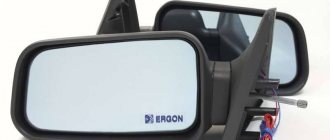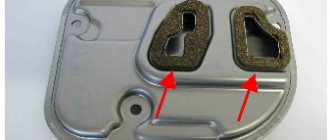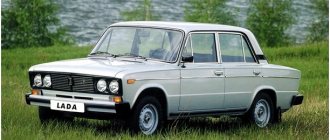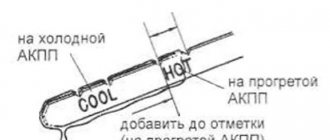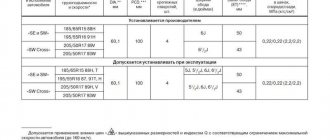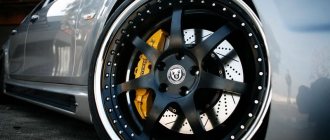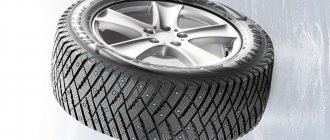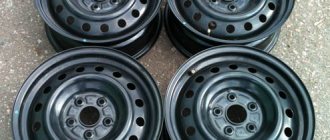Kia Rio is a city family car, classified according to the European classification as class “B”. It has a large interior and a spacious trunk, and is economical in fuel consumption, which distinguishes it very favorably from more bulky cars of class “C” and higher. Let's look at what wheel sizes can be installed on the Rio, and also give recommendations on choosing tires.
Understanding the sizes
The Kia Rio appeared on the European market at the turn of the millennium, in 2000. This was the first generation, produced until 2005 in the following bodies: a five-door hatchback and a sedan.
Year 2000-2005
Several Kia Motors subsidiaries worked on the design of the first Rio. The Japanese branch developed concepts for American and Asian countries, while the European ones tried to satisfy the tastes of their market.
In any case, the car's debut was noisy, and it itself had a very decent exterior and interior design.
The dimensions of the Rio-1 wheels were as follows:
| Modifications | What is the wheel diameter and bolt pattern? | Tire size for Kia Rio | |||
| hub | basic | replacement options | base | replacement options | |
| 1.3I; 1.5I | 54,1 | 5.5Jx13 4/100 ET 40 | 5Jx13 4/100 ET 40 5.5Jx14 4/100 ET 40 | 175/70 R13 | 155/80 R13 175/65 R14 |
| 1.3I (82 лс); 1.5I (95 лс) | 54,1 | 5.5Jx13 4/100 ET 40 | 5.5Jx14 4/100 ET 40 | 175/70 R13 | 175/65 R14 |
| 1.6I | 54,1 | 5.5Jx14 4/100 ET 40 | No options | 175/65 R14 | No options |
| 1.5CRDI | 54,1 | 5Jx14 4/100 ET 39 | 5.5Jx14 4/100 ET 46 5.5Jx15 4/100 ET 46 6.5Jx16 4/100 ET 46 | 175/70 R14 | 185/65 R14 195/55 R15 205/45 R16 |
Year 2006-2011
The second coming of the model called Kia Rio coincided with the beginning of the transformation of Kia Motors. The reorganization turned out to be very effective, and brought this company to the group of world leaders in auto production.
This could not but affect the updated generation of Rio, which debuted in American Detroit in 2005. In fact, the car has already gone beyond the “B” class - it has become larger in size, including an increase in the radius of tires and wheels.
Let's see which wheels are suitable for the second generation Kia Rio - both basic and interchangeable:
| Modifications | What wheels are on the Kia Rio2 | What tire size | |||
| hub | basic | replacement options | base | replacement options | |
| 1.4I; 1.5CRDI; 1.6I | 54,1 | 5Jx14 4/100 ET 39 | 5.5Jx14 4/100 ET 46 5.5Jx15 4/100 ET 46 6.5Jx16 4/100 ET 46 | 175/70 R14 | 185/65 R14 195/55 R15 205/45 R16 |
| 1.1 CRDI; 1.2I; 1.4CRDI | 54,1 | 5.5Jx15 4/100 ET 36 6Jx16 4/100 ET 43 6.5Jx17 4/100 ET 43 | 6Jx15 4/100 ET 48 6Jx16 4/100 ET 52 | 185/65 R15 195/55 R16 205/45 R17 | 185/65 R15 195/55 R16 |
Year 2012 -2016
The next, third generation was presented in 2011 in Geneva. And in fact, under the same name, a completely different car was released.
Dynamic and very distinctive 3- and 5-door hatchbacks and elegant sedans with stylish instrument clusters, climate control and comfortable seats were offered for the European market.
The basic set of wheels has moved from 13 and 14 radii to 16 and 17 inches, which previously could only be used as a replacement option.
The table below shows what tires and wheels are on the third generation Kia Rio:
| Modifications | Disk options | Tires for Kia Rio 3 | |||
| hub | basic | replacement options | base | replacement options | |
| 1.1 CRDI; 1.2I; 1.4CRDI; 1.4I | 54,1 | 5.5Jx15 4/100 ET 36 6Jx16 4/100 ET 43 6.5Jx17 4/100 ET 43 | 6Jx15 4/100 ET 48 6Jx16 4/100 ET 52 | 185/65 R15 195/55 R16 205/45 R17 | 185/65 R15 195/55 R16 |
| 1.6I | 54,1 | 5.5Jx15 4/100 ET 36 6Jx15 4/100 ET 48 6Jx16 4/100 ET 43 6Jx16 4/100 ET 52 6.5Jx17 4/100 ET 43 | No options | 185/65 R15 185/65 R15 195/55 R16 195/55 R16 205/45 R17 | No options |
Year 2022 onwards
The next, fourth Rio model series is equipped with a six-speed manual transmission. The drive is front-wheel drive, the drive wheels are located on a McPherson-type suspension, the rear wheels are on a beam with shock-absorbing hydraulics.
What wheel sizes are standard and which are allowed for replacement:
| Modifications | Disk options | What tires can be supplied | |||
| hub | basic | replacement options | base | replacement options | |
| 1.0 T-GDI 100; 1.0 T-GDI 120; 1.25 MPI; 1.4 CRDI 77; 1.4 CRDI 90; 1.4 MPI; 1.6MPI | 54,1 | 6Jx15 4/100 ET 46 | 6Jx16 4/100 ET 49 6.5Jx17 4/100 ET 49 | 185/65 R15 | 195/55 R16 205/45 R17 |
| 1.1 CRDI; 1.2I; 1.4CRDI; 1.4I | 54,1 | 5.5Jx15 4/100 ET 36 6Jx16 4/100 ET 43 6.5Jx17 4/100 ET 43 | 6Jx15 4/100 ET 48 6Jx16 4/100 ET 52 | 185/65 R15 195/55 R16 205/45 R17 | 185/65 R15 195/55 R16 |
| 1.6I | 54,1 | 5.5Jx15 4/100 ET 36 6Jx15 4/100 ET 48 6Jx16 4/100 ET 43 6Jx16 4/100 ET 52 6.5Jx17 4/100 ET 43 | No options | 185/65 R15 185/65 R15 195/55 R16 195/55 R16 205/45 R17 | No options |
The assembly of these vehicles is organized in the countries where they will be used, or in neighboring ones, because by reducing logistics costs, the cost of the vehicles can be reduced.
Thus, there are branches of the Kia Motors corporation on all continents - including two Kia assembly plants in Russia.
Rio X-Line 2017-2019
In 2022, another version of the Kia Rio was introduced - a crossover with front-wheel drive X-Line, which was positioned as specially created for the Russian market. The appearance of the car is clearly Asian, the interior is decorated in European style.
Let's get acquainted with its modifications and wheel sizes:
| Modifications | Disk options | What tires to put on the Kia Rio X-Line | |||
| hub | basic | replacement options | base | replacement options | |
| 1.4 MPI and 1.6 MPI | 54,1 | 6Jx15 4/100 ET 46 | 6Jx15 4/100 ET 48 6Jx16 4/100 ET 49 | 185/65 R15 | 185/65 R15 195/55 R16 |
What is disc bolt pattern?
The bolt pattern is determined by the ratio of the bolts that secure the discs to the full diameter of the circle. According to the standard, the ratio of 5 to 112 is considered normal. Accordingly, the first number is the indicator of the bolts, and the second is the wheels where the bolts are attached. For each individual car, it is customary to calculate the bolt pattern separately, taking into account the number of bolts, diameter and other factors.
To perform calculations you need to know the wheel sizes. Disks can be classified according to the following criteria:
- Rim width (ensures reliable support).
- Departure (or ET).
Tires for summer
And now we are looking for an answer to the question: “Which summer tires for the Kia Rio are better?” Tires for the summer season for any car are selected depending on its dimensions and classification. And of course, it matters what roads he has to drive on.
Considering that the Rio is a city car, in which hardly anyone will go hunting, a tire with a road tread, as a symmetrical non-directional pattern is usually called, is suitable for it. Here are some worthy examples:
| The best tires for Kia Rio (premium) | Budget options |
| Michelin Energy XM2 | Powertrac CityTour |
| Nokian Hakka Green 2 | Hankook K425 Kinergy Eco |
| Continental ContiEcoContact 5 | Goodyear EfficientGrip Compact |
| Goodyear Eagle Sport | Kormoran Road Performance |
| Bridgestone Turanza T001 | Formula Energy |
The question of which tires are best for the Kia Rio cannot be answered unequivocally. Much depends on the capabilities of the car of a particular modification.
For example, for the third and fourth generations, which can ride on low-profile tires size 205/45 R17, as well as for the Rio X-Line crossover, not only the options presented above are suitable.
Tires with a directional tread pattern, similar to the one in the example below, would also be good.
Michelin CrossClimate+
Not only does it drain water better, reducing the risk of hydroplaning, but it also allows you to reach higher speeds. Only in this case, it is necessary to observe the direction of rotation of the wheels, which is indicated by an arrow on the sidewall of the tire.
Asymmetrical tread patterns are less common; when installing such tires, you also need to observe left and right. But this is no longer an option for class B cars.
The best summer tires
- michelin primacy 4
Our drivers really liked these French brand tires. The vast majority of reviews on them are positive. Owners note a very short braking distance, good directional stability in corners and on uneven roads, reduced fuel consumption, and no aquaplaning. The wear resistance of such rubber is also excellent. The average price of the model is 6,300 rubles.
- Continental ContiPremiumContact
German quality has already become a brand in itself. Continental products meet these high standards and are rightfully one of the most popular on Russian roads. Those who have chosen the model in question note its low noise level, good handling and lack of aquaplaning. Wear resistance is also good and allows the tires to be used for several seasons in a row. This pleasure costs approximately 5,600 rubles for one cylinder.
- Toyo Proxes CF2
The Japanese brand was able to create excellent tires, the main advantages of which drivers call durability, handling and excellent price-quality ratio. There is good stability and traction at high speed even in the rain. The average price for such tires is 5,000 rubles.
- Pirelli Cinturato P1
Italian tire manufacturers are known to all car enthusiasts. A sign of the quality of this brand is the choice of the Formula 1 championship, because it is the exclusive supplier of tires for the grand prix. As for the model in question, it has excellent stability at high speeds, makes little noise and is very durable. However, high quality causes a considerable cost in the amount of 7,000 rubles.
- Hankook Ventus Prime
The Korean company is developing by leaps and bounds. Today Hankuk is one of the market leaders. There are many successful models in the brand’s line, but this one stands out. Its main advantages are strength, road stability, wear resistance and excellent handling. The average price is also very affordable and equals 4,700 rubles.
How to choose winter tires
We've sorted out the summer season, now let's try to figure out how to choose the best winter tires for the Kia Rio. Let’s say right away that they should be winter ones, and not all-season.
Even if the tires bear the M+S badge (which means mud and snow), but the rubber composition is not winter, that is, it does not belong to the friction category - you cannot drive them in winter.
Therefore, you need to decide which winter tires to choose by considering only the studded/friction (Velcro) options. Where the winters are snowy, you have to drive on poorly maintained roads, on uneven terrain, studded tires are definitely more reliable.
However, experienced drivers in any climatic conditions feel comfortable with Velcro. Moreover, it is less noisy, and for those who spend a lot of time driving, this is one of the primary selection criteria.
Now winter is in full swing, so the stores have an excellent assortment, some with several dozen models. We present the most proven premium and economy class options.
Studded
| Premium winter tires for Kia Rio | Economy Class Options |
| Michelin X-Ice North 4 | Yokohama Ice Guard IG55 |
| Goodyear UltraGrip Ice Arctic | Sava Eskimo Stud |
| Toyo Observe Garit G3-Ice | Nordman 7 |
| Bridgestone Blizzak Spike-02 | Tigar Ice |
| Nokian Hakkapeliitta 8 | Gislaved Nord Frost 200 |
| Continental IceContact 2 | Cordiant Snow Cross |
Studless
| Premium winter friction tires | What are the best economy options? |
| Goodyear UltraGrip Ice 2 | Cordiant Winter Drive |
| Bridgestone Blizzak REVO GZ | Powertrac Snowstar |
| Pirelli Winter Cinturato | Nexen Winguard Ice Plus |
| Maxxis SP2 | Hankook W616 I*Cept IZ2 |
| Goodyear Ultragrip 9 | Sava Eskimo S3+ |
| Nokian Hakka Blue 2 | Kumho I Zen KW31 |
The right choice of disk bases for Kia Rio
When installing original elements, car manufacturers guarantee the quality of the product. There are no such conditions for disk bases supplied from unknown companies.
For stamped R15 elements from an unknown manufacturer, the price will be from 1000 to 1500 rubles with no quality guarantees. There are non-original cast elements that can be purchased from 3,000 rubles.
Certified analogues of high quality light alloy wheel bases are also available for sale. In terms of quality and characteristics, they are practically no different from the originals, except for the serial number, and the price will be cheaper, which is what attracts Kia Rio owners.
The highest quality and most expensive are forged stamped elements made from light metals, but such wheels are rarely installed on budget cars.
Most car owners recommend choosing steel elements designed for winter tires. Since in winter the roads are sprinkled with salt, and the original alloy wheels quickly deteriorate.
Several answers to questions
In conclusion, we will try to provide simple and clear answers to the most frequently asked questions.
Question 1. What wheels are best for winter tires?
Answer: Obviously, the term “wheels” here means disks, which, as you know, can be stamped steel or light alloy. From the point of view of the driving performance of the car, it makes no difference what kind of discs you drive on.
But thrifty car owners prefer to install hardware for the winter. Firstly, the beauty of alloy wheels, stained with mud and snow, is still almost invisible.
And secondly, roads are often treated with chemicals that corrode not only the ice, but also the decorative coating on the discs. But again, this is a personal matter for everyone.
Question 2. What pressure should the Kia Rio tires have?
Answer: It depends on the engine modification and wheel size. For cars with a 1.4 liter engine at 14 and 15 radii, the manufacturer has established a standard of 2.1 MPa in the front and rear.
For 1.6L modifications with R16 195/55 wheels, you need to pump 2.2 MPa. Low profile tires R17 205/45 pump 2.7 MPa.
Question 3: Where is the year of manufacture indicated on the tire?
Answer: The date is printed on the sidewall of the tire as a four-digit number. The first pair of digits indicates the serial number of the week, and the second - the year.
Question 4. What year is the best tire to buy?
Answer: The fresher the production date of rubber, the longer it will retain its properties, and the more time the consumer has to make claims if a hidden manufacturing defect is discovered.
According to Russian standards, a passenger tire has a 5-year warranty, so it is better to buy it with the date of the current season, maximum of the previous one.
If you have a model made in Europe (the country is also indicated on the side), then the production date may be earlier. According to European standards, a passenger tire has a 10-year warranty.
Dents in rubber
What does it look like? According to long-term observations, rubber with dents looks exactly like in the photo. That is, the tire has the shape of bumps and dents.
Reason: -This appearance of tires is usually associated with a malfunction of the car’s suspension (wear or damage to the elements of the car’s chassis). Due to a faulty suspension, shock mitigation on bumps is insufficient. Ultimately, the tire begins to experience overload from impacts, thereby taking on the maximum load. But this load is distributed unevenly and differently across the entire tread surface. As a result, some areas of the tread take on more of the load than others, which further contributes to the formation of dents and bumps on the tire itself.
Most often, this appearance of used tires is associated with poor shock absorbers. Although it is also worth noting that any parts of the car’s suspension that are out of order can at any time cause such wear and tear.
We advise you, friends, if such tire deformation is detected, do a complete diagnosis of the car’s suspension and struts by going directly to the technical center. We do not recommend taking such a problem to a tire shop in order to determine the cause of the change in the shape of the wheels. It is not uncommon for tire service workers to not know what can cause irregularities (dents, bumps) to appear on the tread surface.
Most often, tire service workers claim and believe that the reason for this is an incorrect alignment. But this is not a fact. As we said above, this reason may be associated with the same failure of the shock absorber(s).
Dimension
However, before changing the alloy wheels of the KIA Rio X Line, you need to take into account their parameters:
- Width;
- Diameter;
- Bolt pattern;
- Departure;
- Diameter DIA.
Note. This is necessary to avoid unpleasant surprises. For example, if the purchased disc does not fit the parameters, after installation it may rub against the caliper. And this is just one example of possible consequences.
Therefore, when choosing and purchasing wheels for the KIA Rio X Line, you need to focus on the data presented below.
Article on the topic: What is the name of Kia Rio in Korea
The parameters in the tables also depend on the hatchback engine.
Based on the indicated sizes of KIA Rio X Line wheels, you can choose the option you like and avoid installation problems.
Product marking
The marking usually looks like this: 175/70 R13. Let's figure out what the parts of the cipher say:
- The first number (in our case 175) indicates the width of the tire profile, measured in millimeters.
- The second (70) talks about the tire profile height. It is no longer determined in mm, but as a percentage of the width. That is, the entry 175/70 means a wheel width equal to 175 millimeters and a height equal to (0.70 × 175), i.e. 122.5 mm.
- Many people mistakenly believe that the letter R stands for “radius.” In fact, it means the type of tire construction: R - radial, D - diagonal and B - diagonal, equipped with an additional stiffening belt.
- The last number is the diameter (not the radius!), measured in inches.
All manufacturers give certain recommendations for selecting wheels for their cars. In Kia Rio, tire size is also important, and below we will tell you what tires can be installed on each generation of this model.
Standard wheels
At the factory, the Kia Rio X can be equipped with several wheel options, depending on the configuration of a particular vehicle:
- 15-inch steel wheels, tire size 185/65R15;
- 15-inch alloy wheels, dark color, same tire size, 185/65R15;
- 15-inch alloy wheels, tire size 185/65R15;
- 16-inch alloy wheels, tire size 195/60R16.
Article on the topic: How to change a CV joint on a Kia Rio
The width of the rims in all cases will be 6.0J , except for the spare tire, which is 3.5J . It is also possible to order other disks as additional equipment if the ones already on the machine do not suit the buyer. The choice is not so small; in addition, there are protective and decorative caps for stamped wheels and even 2 types of wheel locks.
Kia Rio X disk parameters
| Disk | Departure | PCD (bolt pattern) | DIA (diameter of central center) | Fastening |
| 6Jx15 | ET48 | 4x100 mm | 54.1 mm | Nut M12x1.5 |
| 6Jx16 | ET52 | 4x100 mm | 54.1 mm | Nut M12x1.5 |
On the assembly line, cars receive Korean Kumho or Nexen tires, which are quite budget-friendly and do not have any special driving qualities, but they resist wear quite well. But when replacing there are no restrictions on the manufacturer, but the standard size must strictly match the factory one.
Tire pressure
The answer to the question of what tire pressure is provided for the Kia Rio X is quite simple, in all cases, for all impellers it is the same - 2.3 atm , for a spare reduced size - 4.2 atm.
Pressure Monitoring System (TPMS)
It is based on reading and analyzing the indicators of wheel sensors that record wheel speed. As the tire pressure drops, the total radius of the wheel decreases and it will constantly rotate faster than others.
Since this situation can also occur in other cases, for example when driving in an arc, the system does not immediately raise an alarm, the difference in rotation speed must last a long time or reach significant values.
Article on the topic: Kia Rio 3 generator how many amperes
When the TPMS system is activated, the driver's dashboard will light up an indicator in the form of an exclamation mark framed by the tire profile. False alarms cannot be ruled out, so personal control of the driver is still necessary.
To reset the error after repairing a tire:
- Check the pressure and, if necessary, adjust to the recommended one.
- Hold down the TPMS control button (on the front panel, to the left of the steering column, with the engine running) for at least 3 seconds.
- To confirm the reset, the indicator on the instrument panel should flash for 4 seconds.
